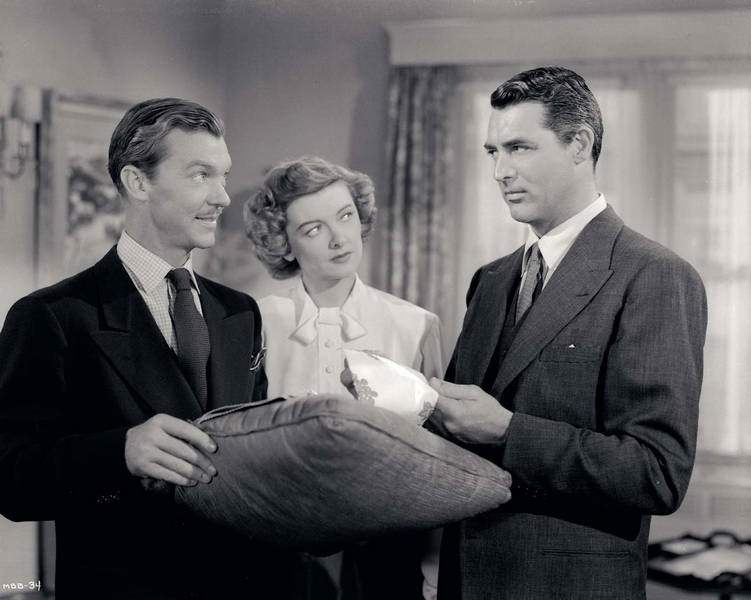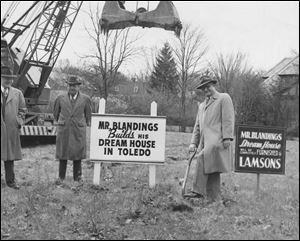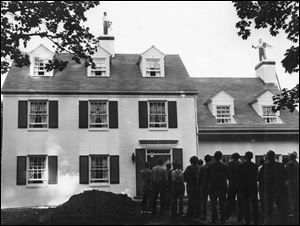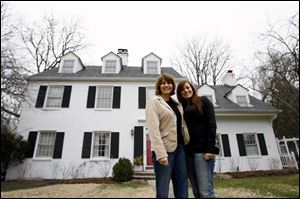
A home made famous in the 1948 mega-hit Mr. Blandings Builds His Dream House is in Ottawa Hills
4/1/2007
Melvyn Douglas, left, Myrna Loy, and Cary Grant starred in the original <i>Mr. Blandings Builds His Dream House.</i>

The 1948 groundbreaking: Parke B. Lamb, Ottawa Hills city manager, left, and Fern L. Kettel, president of the Lamson's department store, which furnished the house.
The house off Bancroft.
It s nothing unusual.
Not a thing sets it apart.
Not the architecture.
Nor the landscaping.
You ve driven past it a thousand times slower than anywhere else you drive in the Toledo area. You ll find it at the bottom of a curl in the road, beyond a glade, nuzzled in the neatly wrapped bedroom enclave of Ottawa Hills. You ve been too busy watching for speed traps to give it much pause. And compared with the sprawling ranch homes that surround it and 1920s mansions that tower behind it, there s no reason you would. The house is relatively modest, quaint, a two-story archetype of post-World War II suburban prosperity.
Painted white, no less.
In fact, you might argue, it was the example of Greatest-Generation-Eisenhower-Uncle-Milty era middle-class good fortune, coziness, and conformity.
The iconic dream house.
Cary Grant thought so.
This house?
Mr. Blanding s.
The very house.
As in, the title home of the 1948 blockbuster Mr. Blandings Builds His Dream House, one of the last great successes for RKO Pictures, and one of the biggest (and most culturally influential) box-office smashes of the late 40s.

Thousands lined up to tour the Ottawa Hills house.
You probably didn t realize this what details exist have long been buried, its heyday long since forgotten, and not a single local historian contacted for this story knew a thing about it but that home off Bancroft Street? It s a replica of the home in the film, constructed 59 years ago by a Hollywood studio as an elaborate promotion for a fluffy romantic comedy (that, to this day, is a Turner Classic Movies staple). It s also played home to four generations of local families, a film set that became a dwelling.
In a sense.
The movie wasn t shot here.
That was on a specially constructed set in Southern California, in Malibu Creek State Park, at the edge of the San Fernando Valley not far from where Fox studios shot the TV series M*A*S*H. That, however, does make this home in Ottawa Hills a reproduction of a fake house built for a real movie about a fake family. A reproduction of a reproduction inside and out.
For a brief two weeks in 1948 Aug. 5 to Aug. 15 it was the talk of Toledo, the leading front-page story in this newspaper. Full-page ads trumpeted: Open for Inspection! Thousands turned out, and lines to get inside snaked from the front door, across the front lawn, to the sidewalk, and down the street.
Rita Kolbeck, 86, of Toledo, recalls:
It was terribly exciting. And I m ashamed to say what I remember best was that the busy wallpaper clashed with a different busy pattern on the sofa cushions it wouldn t have been the way I d have done it!

Melvyn Douglas, left, Myrna Loy, and Cary Grant starred in the original <i>Mr. Blandings Builds His Dream House.</i>
But frivolous thoughts were nice for a change. The war had not yet stopped reverberating in 1948. A couple of years prior, a former editor of Fortune magazine named Eric Hodgins tapped a collective nationwide desire to move on. And out. He wrote the novel Mr. Blandings Builds His Dream House as a lightly mocking stab at this new urbanite need to find a place where families would bloom with country health fed on country milk, country eggs, country butter.
You could see a shift coming in the 1940s, said James Harvey, film historian and author of Movie Love in the Fifties. The culture had not been big on wit. It was the period of film noir. With the war, things turned serious. But by the time of Blandings, there s a romance for normalizing, for going back to living life. So the suburbs were born.
When Hodgins wrote his 1946 bestseller, the nation was still tethered to big concrete urban centers. (Toledo proper had yet to overflow into the hinterlands.) The everyman hero of the Blandings novel and film, Jim Blandings, is a New York advertising executive making a comfortable $15,000 a year, a deeply miserable man who wrote advertising copy and, in another century, might have written sonnets. Fed up with Manhattan, he goes hunting for peace and quiet (and closet space) and finds a colonial in the Connecticut countryside.
A fixer-upper.
Hence, the comedy.
You could never fault Hollywood for not having the pulse of America, said Tim Messer-Kruse, Toledo historian and chair of the Ethnic Studies department at Bowling Green State University. Housing is the big issue when Blandings came out, the big concern for Americans.
At first, the house off Bancroft was not so much a piece of real estate as wish fulfillment a movie-fueled dream made real.
For that extended open house, it was outfitted by the (long defunct) Lamson s department store and as in the movie and the book, the decorating motif was Early American Colonial. The kitchen, on the other hand, was state of the art: a $20,000 all-electric kitchen designed by General Electric (the Microsoft of its day) for the purpose of lightening a woman s daily tasks. Or so boasted the advertising, which, in an early moment of synergy, ran alongside ads for the film s Toledo debut at the Loew s Valentine Theatre.

Debbie Witherell, left, and her daughter, Hayley, live in the Ottawa Hills Blandings replica now.
A lot s been done to the home in 60 years additions, subtractions, the kitchen reshaped, and the once-futuristic deep-freeze unit now called the freezer and taken for granted. Otherwise, the home still looks like Mr. Blandings dream. For reasons of privacy, the address will not be given. A family lives there. They say the house needs work. The paint s starting to peel. But considering the pedigree maybe that s a joke. Mr. Blandings is the forerunner to the fixer-up comedy, the soul of HGTV, and the inspiration for the Tom Hanks hit The Money Pit. On Wednesday, the latest remake opens, Are We Done Yet? partly a sequel to the 2005 comedy Are We There Yet?, partly based on Blandings.
It stars Ice Cube.
Of course, Cary Grant played Mr. Blandings in the original. His wife was played by Myrna Loy. They were box-office royalty. In 1947, the movie mogul David O. Selznick and his publicity man, Paul Macnamara, a former editor of Cosmopolitan, concocted a scheme to promote their new film. They would build replicas of the Dream Home, exact models of the house in the movie. They would raffle off the homes the night of the premiere in each city. They planned to build 100.
They settled for 73, but built them from Bakersfield, Calif., to Portland, Ore., East Natick, N.J., to Worchester, Mass. Some were raffled off, and some were sold.
But why Ottawa Hills?
That s Marc Thompson, village manager of Ottawa Hills. He pulls a blueprint from a drawer behind him, flattens it across his desk. His face is quizzical. It s the initial 1915 plan for the village, the borders of which contain the Blandings house. A lot of this community was built before that home. He flips through a ream of building permits, electrical inspections. Nothing unusual, he says then stops on a name:
Carroll Clark.
Clark s listed as architect.
His address: Hollywood.
Here it gets complicated.
The new people
Oh, that is so cool.
Debbie Witherell puts a hand on her face. She shakes her head, slow, in amazement. The black-and-white photos in her hand are of her home, of the room she s sitting in now, with strangers standing on the front lawn and roof. She s never seen these pictures. She s only the fourth owner of the Blandings residence. Ironically, when she moved here in 1990 with her husband, Martin, she moved from Carty Finkbeiner s old home. Today, her children are in college and high school. Her husband died after a skiing accident in 2000; a well-known lawyer, he was a chairman of CitiFest.
She doesn t know much about the home s history beyond a few basic details. A Bluffton native, she felt she was moving from the country into the city the inverse of Blandings commute. Another irony: She says every change made to the house has been tough to pull off. It s just so well-built. When she and her husband moved in, they would invite friends over to watch the movie, show the place off. She gets up and walks into a closet.
Then she opens the door.
See? Inside locks.
A recurring gag in the movie, Cary Grant keeps getting locked in closets. But these closets have inside locks. Do you know if that was intentionally built that way, because of the movie? But nobody alive knows. She doesn t know where the curtains come from, either. They look suspiciously like the curtains in the film. Originals? She s not certain.
One more irony.
Marie Witherell, her mother-in-law and a former real estate agent, sold her the house; it went for $175,000 (today, it s worth about $345,000). Marie Witherell also handed out tickets to the open house back in 1948. At 84, she remembers famed Toledo architect John Richards being involved, but why she can t remember. She does remember everyone was interested in it, and Ottawa Hills was more separate back then, too. As James Marshall, former manager of local history for the Toledo-Lucas Country Public Library, puts it, The village was sleepy. There was distance between Toledo and Ottawa Hills property lines.
The house went for $70,000.
Or rather, it didn t.
It sat unsold for years.
With good reason.
This is the dawn of America s great building boom, said Mark Lamster, a former editor at Princeton Architectural Press and editor of Architecture and Movies. Men are coming back from the war, starting families. There s a push to the suburbs, and they want classic one-family homes because films are saying every man is a Blandings, and ever since the every-man movie has put every man in a colonial. As for actual suburbs, some cities got them faster than others.
Building boom
In the late 40s, right before the suburbs came into their own, there s a national housing shortage. It s bad everywhere, but it s especially hard in Toledo. You have a building boom fueled by the G.I. Bill, federally insured mortgages, said Tim Messer-Kruse. But at the same time, the banks had crashed. Mortgages had become clouded, and many real estate lots just sat unused.
In 1948, especially.
The year before, the first planned community, Levittown, in Pennsylvania, began as good a starting point for the birth of the suburbs as any. But in Toledo, rationing from the war meant building materials were still scarce. Developments sat half-finished. A five-part series in The Blade at the time concluded if every building material needed was suddenly available and every half-finished home completed, Lucas County would be 4,500 houses short of what was demanded. G.I.s were living with new wives in their parents basements. The average family home was selling for roughly $7,000 and that was pricey.
Everyone s saying, Why don t they build some apartments for the soldiers coming home? remembers artist and Ottawa Hills resident Joe Ann Cousino, 81.
Now here they come with this dream house. It was a big deal, but it didn t go over like a wild hot dog, you know. We d been through a Depression, the banks failing, and the war. The stories of the concentration camps were just starting to come out. Everyone was shocked they picked Ottawa Hills, but what are they doing building that when people can t find wood for new homes?
Eventually, it sells.
Hodgins home, indeed built in Connecticut where the author lived, is the model for the movie house, and according to author Anne Edwards, who bought it decades later, the house became the repository of the American dream, a mecca for movie fans. But it took two years to sell in Toledo. In 1950, Arthur Lennox, a local obstetrician, bought the home for $55,000 a thousand less than Cary Grant spent on the movie s Dream House. The $330 the studio paid for the lot, however, is precisely what Blandings paid for the lot in the book probably just a coincidence.
Icon creator
Now about Carroll Clark.
The art director on Blandings, he designed the house the house in the film, and it turns out, the house in Ottawa Hills.
Born at the turn of the century, he trained as an architect, but the Great Depression rendered the job less than necessary. A lot of art directors at the time started as architects, said Linda Berger, an art director on Forrest Gump and former official with the Art Directors Guild. But they couldn t find work and went on to land jobs at studios. Clark was incredibly talented, incredibly flexible. He would have made that jump without any trouble.
If Blandings helped create the iconic image of the American suburbs, so did Clark. But during his career, Blandings was minor. Clark designed the sets for King Kong, for Hitchcock s Notorious. He built the swanky modernist penthouses of those old Fred Astaire and Ginger Rogers movies including Top Hat. Ginger liked his work so much he designed her house, said John Mansbridge, who followed Clark from RKO to Disney, where he became the studio s art director after Clark died of a heart attack in 1968. (But not before serving as art director on Mary Poppins, The Shaggy Dog, and Old Yeller.)
Blandings was a headache.
Most of the saga of these promotional Blandings homes lies buried in the David O. Selznick Collection, owned by the University of Texas at Austin. Selznick liked to dictate, you could say, said Steve Wilson, curator for the collection. So we have almost 40 boxes of memos on just Mr. Blandings. It was one of the first movies to be heavily merchandised, and Selznick had his hands in everything, from blueprints sold commercially to tie-in refrigerators and ovens.
In Toledo, Selznick lined up the Suez Co. as the contractor. It was owned by Bob Etchen, something of a character who built many of the brick apartment buildings on Douglas Road and would run a PT boat up and down the Maumee River. When the plans for the Blandings house were mailed to contractors around the country, Etchen and others found something of a flaw. RKO had sent Clark s blueprints for the movie sets. Because they were movie sets, only what was to show on camera was included. Therefore, the plans for the Blandings promotional homes initially had no stairs to their second floors, and rooms lacked closets and windows.
Our inexperience in the building business has became apparent, wrote Selznick publicist Paul Macnamara. Mansbridge, who worked on Blandings, remembers film publicists taking photos of every inch of the set to send to contractors. He said Clark probably had to go back and redo every blueprint with building codes of each city in mind all 73, the locations presumably chosen to reflect the top 73 film markets of the time.
How many are left?
Difficult to say.
Trinity Smith owns one in Oklahoma City with her husband, Brian. It was in bad shape when they bought it (ironically). Now people drive by all the time and snap pictures. Blandings author Hodgins sold the original because he d spent too much on the repairs. (With the $20,000 he made by selling the film rights, he tried to buy it back. The new owners refused.) In Bel Air, Calif., one Blandings home was raffled to a man who couldn t pay the property taxes he killed himself a couple of years after moving in. As for the actual movie set: It was fleshed out and turned into the Malibu Creek State Park ranger station, where it remains today.
The rest are probably like the house in Ottawa Hills a slice of pop culture that, like all pop culture, gradually lost its context and calcified into actual history. Indeed, oddly, a number of people contacted for this story had thought the University of Toledo president once lived there. This all sounds like the ultimate cult of celebrity to me, said Gary Hoppenstand, editor of the Journal of Popular Culture at Michigan State University. To live in the ultimate reflection of the American suburban sitcom.
We want our homes to be refuges, and the American suburban home promises to heal all things that are troubling about America, said Alain De Botton, author of The Architecture of Happiness. One couldn t call [Blanding s home] great architecture. But it is good shelter.
Debbie Witherell doesn t remember closing on the house with any of that in mind. You buy a house for other reasons. It fit. Her daughter, Hayley, echoes her. The film stuff is secondary.
When I have a boyfriend I will tell them it s Mr. Blandings Dream House and they usually don t have a clue what I m talking about. And the same with friends. Someone will say I have such a pretty house and I will try explaining where it came from.
When I remember.
SContact Christopher Borrelli at: cborrelli@theblade.comor 419-724-6117.